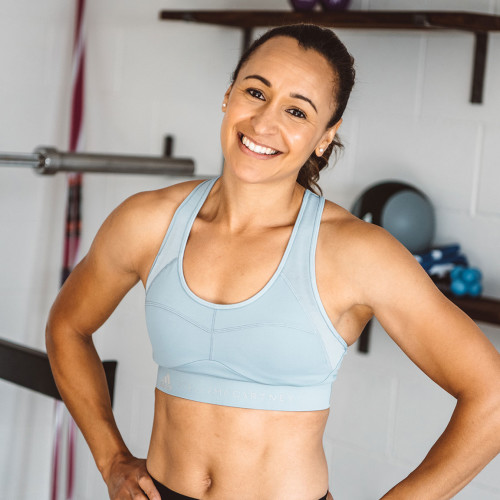How should I adapt my training if I’m a runner going through perimenopause?
9 months ago
Perimenopause9 months ago
Perimenopause
Running has big benefits before, during and after menopause. But, sticking with the same running plan might not be the right strategy for your body when you’re perimenopausal. Hormonal health expert Dr Nicky Keay shares the smartest ways to adapt your sessions for running success…
Running can have a hugely positive impact on your body and mind. But, if you’re a regular runner heading into perimenopause, focusing purely on going faster and harder, or ticking off bigger events might not be right for your body – and you may see your performance slip as a result.
Here, we look at the latest research and speak to Dr Nicky Keay , a medical doctor and specialist in hormonal health about how to keep running strong through perimenopause.
Our bodies are changing as we enter perimenopause, so it’s no wonder that these changes will impact our running performance. With your oestrogen and progesterone levels fluctuating and gradually hitting their lowest levels, research shows that our muscle strength, power and speed can also take a hit.
But, with this stage, comes a big opportunity. It’s the perfect time to take a breather and figure out how to work more in harmony with your body – and it’s also a chance to go for focused, quality sessions that get you the results you want, rather than throwaway ‘junk’ sessions that involve running for the sake of it.
Running puts your body under physical stress (which is a good thing, in small doses) but it’s during your recovery time that your body repairs, recharges and adapts. “If you’ve previously trained for events, you’ll have periodised your training and you’ll have light and shade in your training. So, this time in your hormone journey isn’t too different,” says Dr Nicky.
Swapping out two runs a week for a strength session will reap maximum rewards to both your perimenopausal body and your running performance
“If your body feels overloaded, this will increase your stress response hormone, cortisol – a hormone that also favours fat accumulation,” says Dr Nicky. “So, making rest days as important as the days you run comes with even bigger benefits now.” If you feel fatigued or notice that your heart rate increases throughout the day (without exercising), or that your heart rate variability is decreasing, it might be that your body isn’t coping well with the load. This is your cue to reduce the intensity or rest completely, to help prevent overtraining or injury.
If you want to feel stronger when running, it’s time to add more strength training to your routine. “You might feel tempted to just add more and more cardio,” explains Dr Nicky. “But, mixing it up will benefit you as a runner, and strength training will help you build more lean muscle and feel stronger during all your other favourite workouts too.” This is particularly important for perimenopausal women, who are prone to muscle loss - s ee more here .
You might worry that time away from simply pounding the pavements will be detrimental to your running performance, but simply swapping out two runs a week for a strength session will reap maximum rewards to both your perimenopausal body and your running performance.
A Norwegian study found that those who did strength training three times a week across eight weeks increased their running economy (how efficiently you use energy when running at intensity) by 5%. They also improved their overall time to exhaustion on the treadmill by 21%. Researchers chalk it up to strength training helping them increase muscle efficiency, leading to a quicker stride and more energy saved while running.
Strength training also spells good news for your bones. With oestrogen levels beginning to decrease from perimenopause, our bone density also starts to decrease. While the impact of running helps strengthen your bones, this type of movement is unidirectional (movement in a single direction). Your bones also need multi-directional movement to stay at their strongest – research proves that resistance training is great for this, as are sports like netball and football. Dance is also great for bone health.
“We’re all human and we like doing what we’re good at. For you, it might be the same run on the same route every Sunday, then shorter laps around the same park mid-week. However, variety is how you get fitter and healthier.
“If you always give your body the same run, you won’t adapt and you won’t progress,” says Nicky, “so now’s the time to think about mixing up the runs that you do to challenge your body in the right way.” That could mean adding a hill run in once a week or trying a Jennis HIIT run for an easy interval / Fartlek session where we do all the thinking for you.
If you notice yourself slowing down during your runs, it’s tempting to panic and keep going harder. But, by running both your shorter and longer runs too fast, you may be overloading your body and delaying all the benefits you get in recovery.
Factor in shorter and steadier runs and make a conscious effort to go easy
Figuring out how to run in the right ‘zone’ or intensity for you will make a big difference during perimenopause. This is the level of intensity that allows you to get all the good stuff from your run – like working your heart so that it can function at its optimum level – without pushing yourself over the edge.
When you run at the faster, harder end of your range, this puts lots of stress and load on your body. When you run on the slower, steadier end, you put less stress and wear and tear on your body. So, the benefits of the two start evening out. The take home? Factor in shorter and steadier runs and make a conscious effort to go easy. This means that when it comes to your harder, intense ones, you’ve got energy in the tank and you’re not overdoing it.
Of course, running goals and events require pretty strict training plans, but with our bone and muscle health starting to decline during perimenopause, a stretch or yoga session after a long run is an insurance policy against injury.
When it comes to nutrition, if you're eating a varied diet with good intake of protein, then you should be getting all the nutrients you need to stay healthy through perimenopause and beyond. “However, the exception is vitamin D,” says Nicky. “The main source of vitamin D is the action of sunlight on skin. Living in the UK means sunlight is in short supply, so we all need to supplement, especially over winter months to maintain bone, muscle and immune health.”
 Cycle syncing
Cycle syncing Perimenopause
Perimenopause Perimenopause
Perimenopause Perimenopause
PerimenopauseSign up to learn everything you need to know about CycleMapping, plus how you can live better and feel better through optimising your fitness to you.
This website uses cookies to ensure you get the best experience on our website. Learn more

Sign up for the very latest news on women's fitness, health and hormones, plus be the first to receive exclusive offers and extras